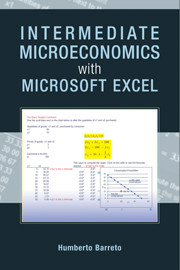Book contents
- Frontmatter
- Contents
- Preface
- User Guide
- Introduction
- PART I THE THEORY OF CONSUMER BEHAVIOR
- PART II THE THEORY OF THE FIRM
- 2.1 Production Function
- 2.2 Input Cost Minimization
- 2.3 Output Profit Maximization
- 2.4 Input Profit Maximization
- 2.5 Consistency in the Theory of the Firm
- 2.6 Monopoly
- 2.7 Game Theory
- PART III THE MARKET SYSTEM
- Conclusion
- Index
2.3 - Output Profit Maximization
from PART II - THE THEORY OF THE FIRM
Published online by Cambridge University Press: 05 June 2012
- Frontmatter
- Contents
- Preface
- User Guide
- Introduction
- PART I THE THEORY OF CONSUMER BEHAVIOR
- PART II THE THEORY OF THE FIRM
- 2.1 Production Function
- 2.2 Input Cost Minimization
- 2.3 Output Profit Maximization
- 2.4 Input Profit Maximization
- 2.5 Consistency in the Theory of the Firm
- 2.6 Monopoly
- 2.7 Game Theory
- PART III THE MARKET SYSTEM
- Conclusion
- Index
Summary
There are many occasions, therefore, when several explorers are surprised, and somewhat pained, on meeting each other at the Pole. Of such an occasion the history of the “marginal revenue curve” presents a striking example. This piece of apparatus plays a great part in my work, and my book arose out of the attempt to apply it to various problems, but I was not myself one of the many explorers who arrived in rapid succession at this particular Pole.
Joan RobinsonThis chapter works with a perfectly competitive, PC, firm in the short run, SR.
With a cost function, TC* = f(q, w, r, and production functions parameters), we are ready to solve the PCSR firm's output side profit maximization problem. This is the second of three optimization problems that make up the Theory of the Firm.
The firm chooses the amount of output that maximizes profit, defined as total revenue minus total cost.
The firm's market structure impacts its revenue function. The simplest case is a perfectly (or purely) competitive firm. A PC firm takes price as given and, therefore, revenues are simply price times quantity. Total cost comes from the cost function (choosing the input mix that minimizes the cost of any given level of output).
The short run is defined by the fact that at least one input (usually K) is fixed and cannot be varied. In the long run, the firm is free to choose how much to use of each factor.
- Type
- Chapter
- Information
- Intermediate Microeconomics with Microsoft Excel , pp. 321 - 354Publisher: Cambridge University PressPrint publication year: 2009



